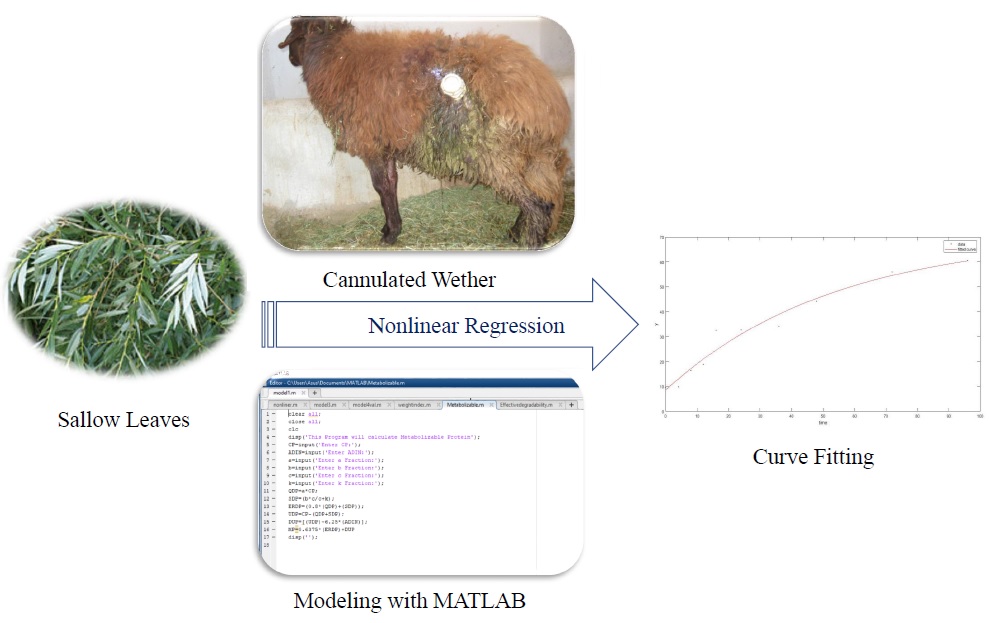Degradación ruminal in situ de hojas de árboles cetrinos utilizando diferentes modelos matemáticos
In situ ruminal degradation of sallow tree leaves using different mathematical models

Mostrar biografía de los autores
Objetivo. El objetivo de presente estudio fue determinar los parámetros de digestión in situ de las hojas cetrinas (Salix Alba) como alimento alternativo, no utilizado comúnmente en dietas animales utilizando modelos matemáticos. Materiales y métodos. Se utilizaron cuatro modelos matemáticos para describir la desaparición ruminal de materia seca (MS) y proteína cruda (PC) de hojas cetrinas: exponencial no rezagado (Modelo I); exponencial rezagado (Modelo II); Gompertz (Modelo III) y Mitscherlich generalizado (Modelo IV). Resultados. Los resultados de las características de degradabilidad de DM y CP mostraron que todos los modelos se ajustaban bien (r2>0.98) a los datos de desaparición y había pequeñas diferencias entre los modelos en términos de evaluaciones estadísticas. Sin embargo, los modelos diferían en los parámetros estimados dependiendo de la naturaleza y estructura del modelo y los parámetros incluidos. Conclusiones. Dado que algunos modelos estimaron valores negativos para los parámetros estudiados, estos no fueron biológicamente aceptables. Por esta razón, solo el modelo I puede usarse para estimar la degradabilidad de MS y PC de hojas cetrinas. En términos de degradabilidad efectiva (DE) de la DM, el modelo III, debido a la estimación de valores negativos para la parte A, no se utilizó en los cálculos. Debido a que las hojas cetrinas constituyen la mayor proporción posible de las fracciones de degradabilidad ruminal y la degradabilidad efectiva, se puede utilizar como fuente de forraje en alimentos para rumiantes.
Visitas del artículo 627 | Visitas PDF
Descargas
- Ebeid HM, Kholif AE, Chrenkova M, Anele U. Ruminal fermentation kinetics of Moringa oleifera leaf and seed as protein feeds in dairy cow diets: in sacco degradability and protein and fiber fractions assessed by the CNCPS method. Agrofor Sys. 2019; https://doi.org/10.1007/s10457-019-00456-7
- Mune MAM, Nyobe EC, Bassogog CB, Minka SR. A comparison on the nutritional quality of proteins from Moringa oleifera leaves and seeds. Coge Food Agric. 2016; https://doi.org/10.1080/23311932.2016.1213618
- Obeidat BS, Kridli RT, Mahmoud KZ, Obeidat MD, Haddad SG, Subih HS, Al-Khazáleh JM. Replacing Soybean Meal with Sesame Meal in the Diets of Lactating Awassi Ewes Suckling Single Lambs: Nutrient Digestibility, Milk Production, and Lamb Growth. Animals. 2019; 9(4):157. https://doi.org/10.3390/ani9040157
- Mishra B, Varjani S, Varma GKS. Agro-industrial by-products in the synthesis of food grade microbial pigments: An eco-friendly alternative. In Green Bio-processes. Springer, Singapore. 2019; https://doi.org/10.1007/978-981-13-3263-0_13
- Palangi V, Khoshvaghti H, Sharafi Y, Eivazi P. Determination of nutritive value of Sallow and Service leaves using nylon bags and gas production techniques. Ind J Anim Res. 2012; 40:361-365. https://arccjournals.com/journal/indian-journal-of-animal-research/ARCC480
- Palangi V, Taghizadeh A, Sadeghzadeh MK. Determine of nutritive value of dried citrus pulp various using in situ and gas production techniques. J Biodivers Environ Sci. 2013; 3:8-16. https://innspub.net/wp-content/uploads/2013/06/JBES-Vol3No6-p8-16.pdf
- Palangi V, Macit M. In situ crude protein and dry matter ruminal degradability of heat-treated barley. Rev Méd Vét. 2019; 170:123-128. https://www.revmedvet.com/2019/RMV170_123_128.pdf
- Palangi V, Macit M, Bayat AR. Comparison of mathematical models describing disappearance curves from the in sacco technique for incubating lucerne hay cuts in the rumen. South Afric J Anim Sci. 2020, 50(5):719-715. http://dx.doi.org/10.4314/sajas.v50i5.9
- Dhanoa MS, France J, Siddons RC, Lopez S, Buchanan SJG. A non-linear compartmental model to describe for age degradation kinetics during incubation in polyester bags in the rumen. British J Nut. 1995; 73:3-15. https://doi.org/10.1079/BJN19950004
- France J, Thornley JHM, Lopez S, Siddons RC, Dhanoa MS, Van Soest PJ, Gill M. On the two-compartment model for estimating extent of feed degradation in the rumen. J Theo Biol. 1990; 146:269–287. https://doi.org/10.1016/S0022-5193(05)80139-0
- Ørskov ER, McDonald I. The estimation of protein degrability in the rumen from incubation measurements weighted according to rate of passage. J Agric Sci. 1979; 92:499-503. https://doi.org/10.1017/S0021859600063048
- Çavdar T, Mohammad M, Milani R A. A new heuristic approach for inverse kinematics of robot arms. Adv Sci Lett. 2013; 19(1):329-333. https://doi.org/10.1166/asl.2013.4700
- Palangi V, Besharati M. Validation of in situ disappearance curves utilizing mathematical models for incubating fish meal and cottonseed meal. Semin. Ciênc. Agrár. 2020; 41(6Supl2): 3391-3396. https://doi.org/10.5433/16790359.2020v41n6Supl2p3391
- Ørskov ER, Hovel FDB, Mould FL. The use of the nylon bag technique for evaluation of feedstuffs. Trop Anim Prod. 1980; 5:195-213. http://www.fao.org/WAICENT/faoINFO/AGRICULT/AGA/AGAP/FRG/TAP53/53_1.pdf
- Yanez Ruiz DR, Martin Garcia AI, Moumen A, Molina Alcaide E. Ruminal fermentation and degradation patterns protozoa population and urinary purine derivatives excretion in goats and wethers fed diets based on olive leaves. J Anim Sci. 2004; 82(7):2023–2032. https://doi.org/10.2527/2004.8272023x
- Elahi MY, Rouzbehan Y. Characteriztion of quercus persica, quercus infectorica and quercus libani as ruminant feeds. Anim Feed Sci Technol. 2008; 140:78-89. https://doi.org/10.1016/j.anifeedsci.2007.02.009
- Waghorn GC, Shelton ID, McNabb WC, McCutcheon SN. Effects of condensed tannins in Lotus pedunculatus on its nutritive value for sheep. 2. Nitrogenous aspects. J Agric Sci. 1994; 123:109-119. https://doi.org/10.1017/S0021859600067836























